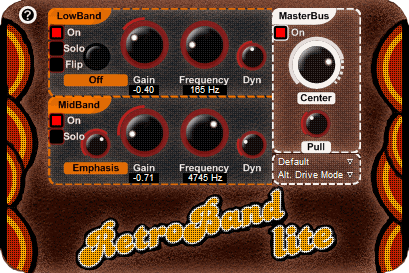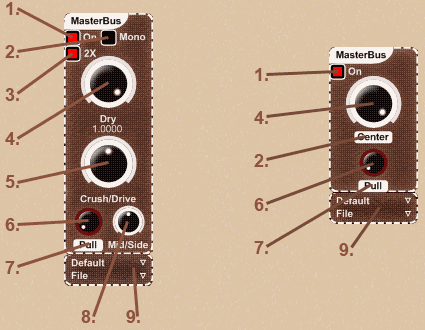The Concept
RetroBand models several interaction aspects of gain stages and transformers. It generates IMD and crossover distortions present especially in Class A/B gain stages. RetroBand also features several forms of transient shaping. As opposed to sterile but perfect digital sound, IMD and cross-over distortions can sound good. They are present in most vintage gear.

Throw a spanner in the perfect digital engine
The three different bands (the midbands are identical) are all independent designs. No particular piece of equipment is simulated in any of them, but the combined flexibility can generate some of the desirable aspects of great sounding gear. It could be said RetroBand is one of the missing links to analog sound in a digital audio workstation.
The Sound
RetroBand is a distortion unit at heart. It does warming, sharpening, roughing up, softening and smoothing - or all these combined. It may enrich sterile sound sources. Failing equipment can be easily simulated. With some luck it makes things sound "larger than life". The transient enhanced distortion models with mid-side stereo controls can change or revive a stereo image.

The Controls
Retroband is not an easy to use plugin. All the bands feature slightly different processing variations, but the controls work the same for all of them. The naming of the controls may look familiar from dynamic equalisers, but that's where the similarity ends. At all times keep in mind that transient-enhanced distortion is extremely sensitive to audio dynamics. Often you'll find RetroBand barely reacting to transients while the same setting will completely destroy different type of material.
- RetroBand Tip: What to do if you're only getting undesirable grinding/warbling/screeching sounds? Find an interesting frequency area, starting with very subtle gains and with the knowledge that cutting gain is usually better than boosting. Gain, Solo and Frequency controls are your best friends.
The Individual Bands

- 1. On/Off button. If a band is turned off, it will no longer use any CPU. Remember to turn off any unused bands!
- 2. Solo lets you to listen to each channel individually. A word of advice: listening to a bare distortion model does not represent the final combined sound very well. An individual band in conjunction with the original sound is where the magic (or destruction) happens. You might hear something entirely different on the soloed bands than on the final mixed result.
- 3. Flip mode of the LowBand. This is a slightly more aggressive version mode of the LowBand, generating ring modulation like artifacts. A great practise is to cut slightly with a relatively high frequency value, generating a kind of destructive low cut of the signal, usually with good sounding, or at least interesting results.
- 4. and 5. Emphasis/de-emphasis of the pre-distortion transient - the first stage of processing. Click the label to change the mode. This feature is tremendously sensitive to audio dynamics and the same setting will rarely work on two different types of audio sources.
- 6. Gain is the amount of distortion. This is the most important control of the plug-in. Positive gain means additive distortion, while negative gain is subtractive. Due to the nature of the process negative gain might at some point flip back to half band-mirroring of positive gain producing interesting results.
- 7. The frequency of the distortion band. This is where 'LowBand' differs to the other bands most, and is generally only suitable to processing low frequencies of audio. 'MidBands' both feature the same model, while 'FlexiBand' is a yet another different model. Due to the somewhat unpreditable reactance to various audio material, experimentation is the key.
- 8. Noise adds pink noise into the distortion engine and depending on the band settings it may generate useful results. It can create a wide range of analog equipment internal hiss, scratch and rumble. This is the kind of noise you might sometimes want to add on your recordings instead removing it as it can make things sound old and worn.
- 9. Q sets the width of the distortion frequency band. Generally it should be kept at the default setting.
- 10. Mid/Side lets you process between the middle or the side parts of a stereo signal. In conjunction with the transient stages this may result in very useful stereo imaging tricks. When a band is processing very low frequencies, it's adviceable to set the knob fully to the left side (mono) for more a coherent stereo image.
- 11. Dyn emphasises the post-distortion transient. Its sensitivity to source material is borderline dangerous.
The MasterBus

- 1. On/Off bypasses the plug-in.
- 2. Mono sets all processing to mono, with selectable mono source: stereo sum, left channel and right channel. CPU usage is reduced in all mono modes, which is handy in busy mixdowns.
- 3. 2X set processing to 2X oversampling when needed. The oversampling of RetroBand isn't especially CPU hungry and should always be kept on for better sound quality. With some source material the diffence between the modes can be too subtle, and 1X mode should be used in that case. Auto-mode uses 2X oversampling only during offline exports in hosts that support it.
- 4. Dry sets the level of the original input audio. This control is tremendously handy when homing in on good sounding distortions. Generally it should be kept close to the maximum value, as the models very rarely sound good on their own. Remember that the models are designed to work only when being mixed to the dry signal.
- 5. Drive is the master control of transient processing in the plug-in, affecting all the bands. It helps when there's excessive transient spikes happening, or when the transient controls are have too little effect. If you can't hear what Emphasis/de-emphasis and Dyn knobs are doing, set the drive higher. Keep in mind this control is highly source material dependant.
- 6. and 7. Controls the amount of non-distorted transient emphasis or de-emphasis of the MasterBus dry signal. Click the label to change the mode. Pull is for boosting transients and Push works similarly to plain saturation. It doesn't hurt to always "pull" the audio just a little bit.
- 8. Mid/Side controls the spread of the MasterBus transient processing. Numerous stereo image shaping tricks are possible here and they work especially well on full mixes.
- 9. Presets and additional options. All the presets are designed to work only as starting points. They are generally way too strong for all types of material and a goog tip is to simply turn down the individual Gain knobs of each band. Alternative Noise Mode is a new feature in the 1.5 version. By default the noise behaviour has been completely revised. When you use the noise knobs, you no longer hear any of the actual hiss and rumble, but only the residual effect on the signal. The alternative mode is the old noise behaviour with all the crackles and hum left intact. Alternative Drive Mode has a particularly nasty effect on all distortion of RetroBand. It should be left off most of the time, but sound designers will appreciate the option. -6dB Output is a safety switch that does what it says on the tin. Hi-pass 100Hz is a kind of safety feature as well, for situations when RetroBand is producing too much low frequency rumble. It filters both the input and output of the processed signal, but doesn't touch the original audio. Of course it can be used in sound shaping as well.
Features
- Digital model of interaction between gain stages and transformers
- Three flexible distortion models with noise modulation
- Transient shaping within the distortion models
- Mid-side stereo image controls
- Advanced noise modes to imprint effects of noise on signal without the hiss and rumble
- 64-bit signal path with highly optimised algorithms
Requirements
- A host with VST plug-in support
- Windows 2000, Windows XP, Windows Vista, Windows 7 or OSX Tiger
Note to Windows users: the plugins are stable with 64-bit VST host applications using jBridge.
Note to OSX users: there's no AU or RTAS support but the plugins work with VST-to-AU and VST-to-RTAS adapters.